Effectiveness of Spinal Cord Injury Treatments: A Systematic Review
VerifiedAdded on 2021/05/31
|20
|5248
|22
Report
AI Summary
This systematic review compares the effectiveness of spinal decompression surgery and stem cell therapy for treating spinal cord injuries (SCIs). The report examines the methodology, including the research question (PICO framework), search terms, and inclusion/exclusion criteria used to identify relevant articles. The review analyzes six articles, discussing the features of stem cells, benefits of decompression surgery, sample characteristics, ASIA and BMS scores, adverse effects, and cost-effectiveness. The findings highlight the potential of both interventions, with stem cell therapy focusing on regeneration and decompression surgery aiming to relieve pressure. The review concludes with recommendations based on the comparative analysis of these two treatment options for SCIs, emphasizing the need for further research and evidence-based practices.
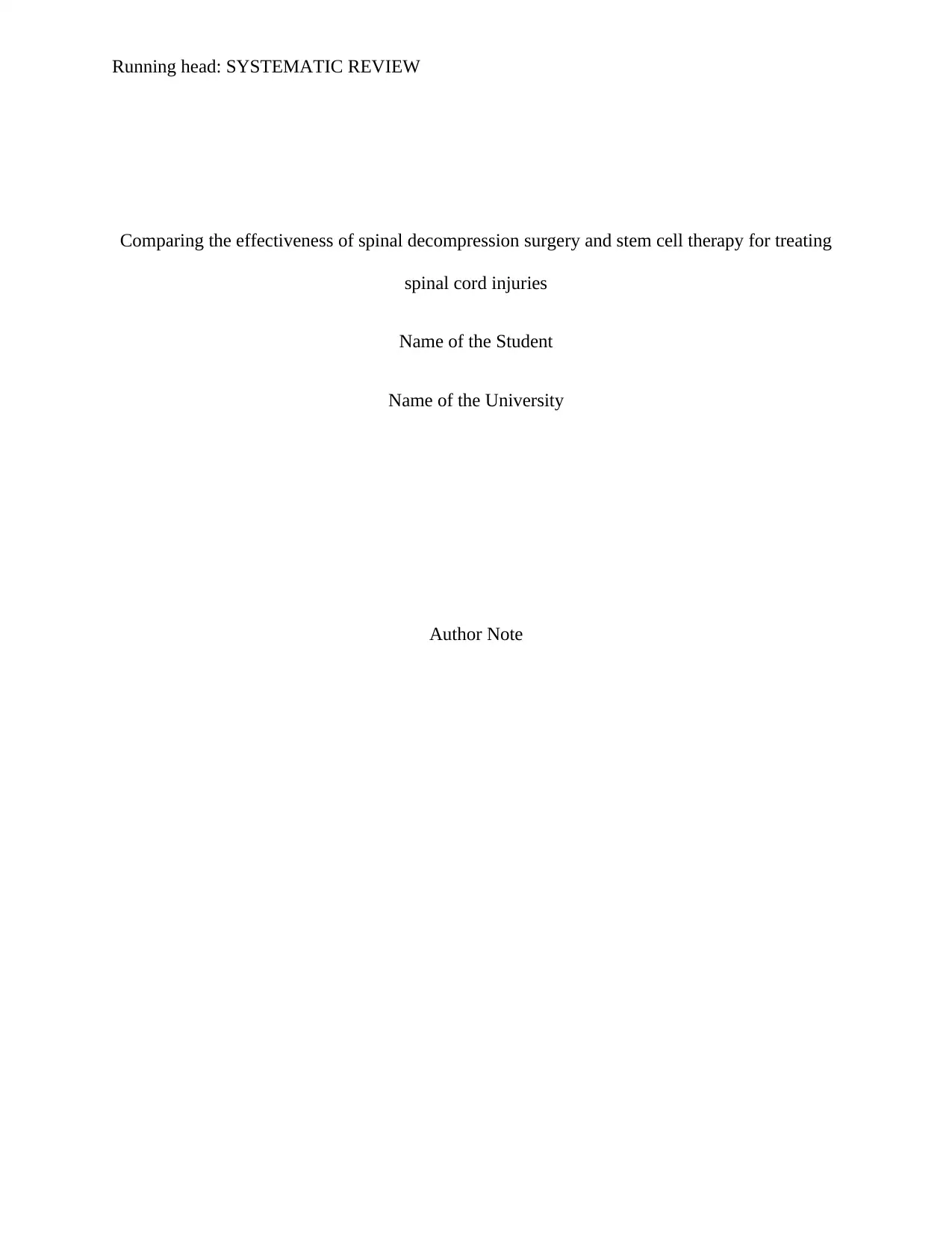
Running head: SYSTEMATIC REVIEW
Comparing the effectiveness of spinal decompression surgery and stem cell therapy for treating
spinal cord injuries
Name of the Student
Name of the University
Author Note
Comparing the effectiveness of spinal decompression surgery and stem cell therapy for treating
spinal cord injuries
Name of the Student
Name of the University
Author Note
Paraphrase This Document
Need a fresh take? Get an instant paraphrase of this document with our AI Paraphraser
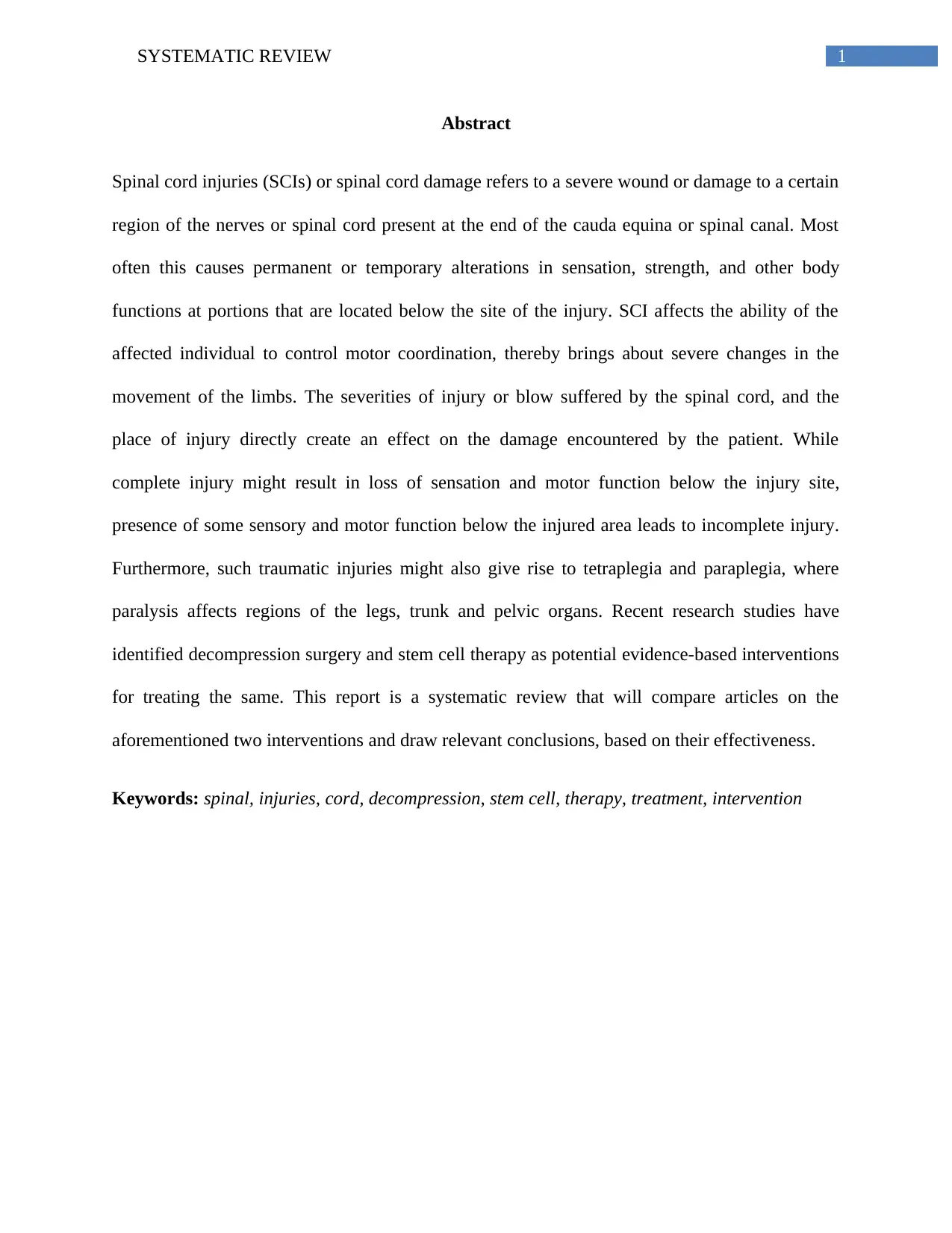
1SYSTEMATIC REVIEW
Abstract
Spinal cord injuries (SCIs) or spinal cord damage refers to a severe wound or damage to a certain
region of the nerves or spinal cord present at the end of the cauda equina or spinal canal. Most
often this causes permanent or temporary alterations in sensation, strength, and other body
functions at portions that are located below the site of the injury. SCI affects the ability of the
affected individual to control motor coordination, thereby brings about severe changes in the
movement of the limbs. The severities of injury or blow suffered by the spinal cord, and the
place of injury directly create an effect on the damage encountered by the patient. While
complete injury might result in loss of sensation and motor function below the injury site,
presence of some sensory and motor function below the injured area leads to incomplete injury.
Furthermore, such traumatic injuries might also give rise to tetraplegia and paraplegia, where
paralysis affects regions of the legs, trunk and pelvic organs. Recent research studies have
identified decompression surgery and stem cell therapy as potential evidence-based interventions
for treating the same. This report is a systematic review that will compare articles on the
aforementioned two interventions and draw relevant conclusions, based on their effectiveness.
Keywords: spinal, injuries, cord, decompression, stem cell, therapy, treatment, intervention
Abstract
Spinal cord injuries (SCIs) or spinal cord damage refers to a severe wound or damage to a certain
region of the nerves or spinal cord present at the end of the cauda equina or spinal canal. Most
often this causes permanent or temporary alterations in sensation, strength, and other body
functions at portions that are located below the site of the injury. SCI affects the ability of the
affected individual to control motor coordination, thereby brings about severe changes in the
movement of the limbs. The severities of injury or blow suffered by the spinal cord, and the
place of injury directly create an effect on the damage encountered by the patient. While
complete injury might result in loss of sensation and motor function below the injury site,
presence of some sensory and motor function below the injured area leads to incomplete injury.
Furthermore, such traumatic injuries might also give rise to tetraplegia and paraplegia, where
paralysis affects regions of the legs, trunk and pelvic organs. Recent research studies have
identified decompression surgery and stem cell therapy as potential evidence-based interventions
for treating the same. This report is a systematic review that will compare articles on the
aforementioned two interventions and draw relevant conclusions, based on their effectiveness.
Keywords: spinal, injuries, cord, decompression, stem cell, therapy, treatment, intervention
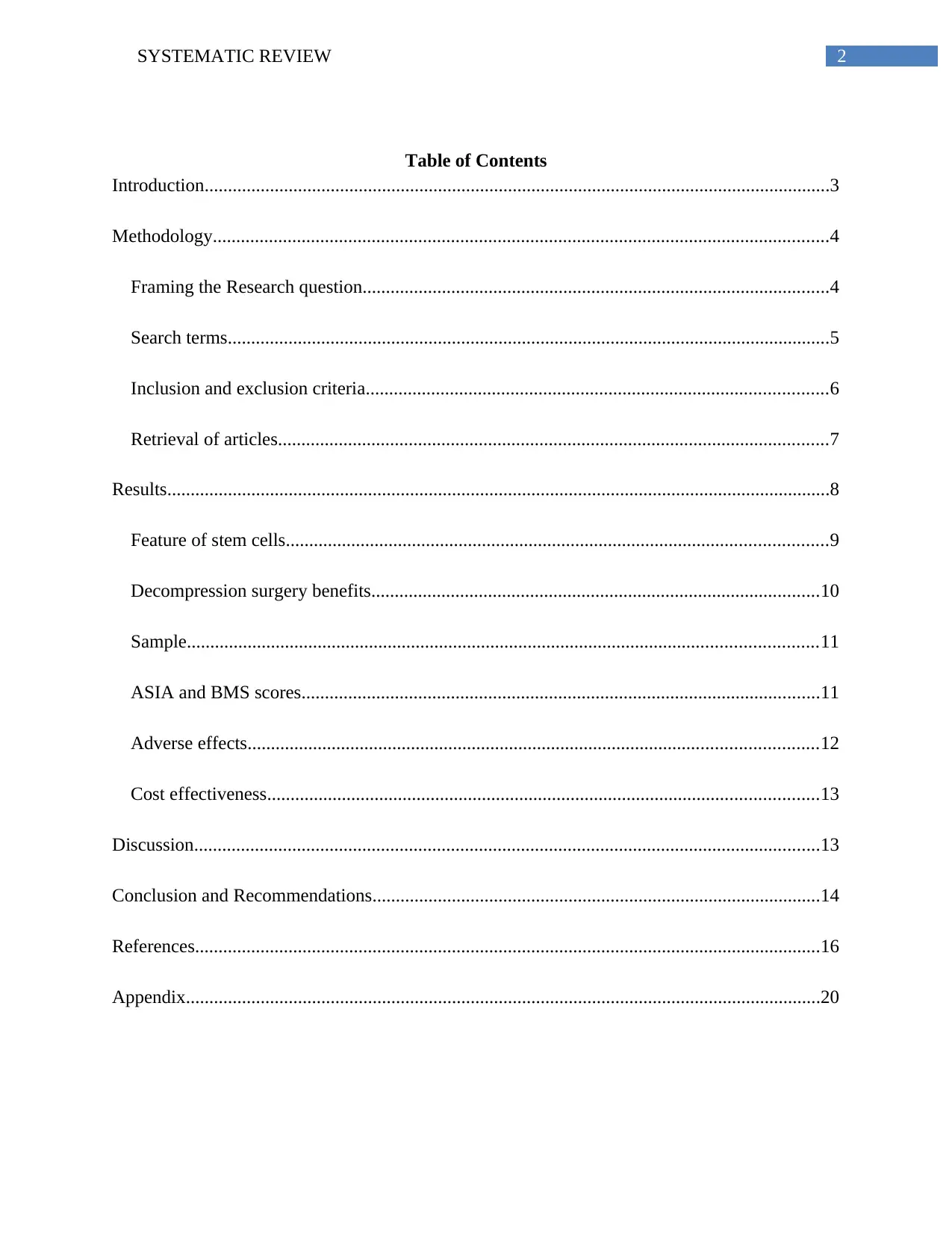
2SYSTEMATIC REVIEW
Table of Contents
Introduction......................................................................................................................................3
Methodology....................................................................................................................................4
Framing the Research question....................................................................................................4
Search terms.................................................................................................................................5
Inclusion and exclusion criteria...................................................................................................6
Retrieval of articles......................................................................................................................7
Results..............................................................................................................................................8
Feature of stem cells....................................................................................................................9
Decompression surgery benefits................................................................................................10
Sample.......................................................................................................................................11
ASIA and BMS scores...............................................................................................................11
Adverse effects..........................................................................................................................12
Cost effectiveness......................................................................................................................13
Discussion......................................................................................................................................13
Conclusion and Recommendations................................................................................................14
References......................................................................................................................................16
Appendix........................................................................................................................................20
Table of Contents
Introduction......................................................................................................................................3
Methodology....................................................................................................................................4
Framing the Research question....................................................................................................4
Search terms.................................................................................................................................5
Inclusion and exclusion criteria...................................................................................................6
Retrieval of articles......................................................................................................................7
Results..............................................................................................................................................8
Feature of stem cells....................................................................................................................9
Decompression surgery benefits................................................................................................10
Sample.......................................................................................................................................11
ASIA and BMS scores...............................................................................................................11
Adverse effects..........................................................................................................................12
Cost effectiveness......................................................................................................................13
Discussion......................................................................................................................................13
Conclusion and Recommendations................................................................................................14
References......................................................................................................................................16
Appendix........................................................................................................................................20
⊘ This is a preview!⊘
Do you want full access?
Subscribe today to unlock all pages.

Trusted by 1+ million students worldwide
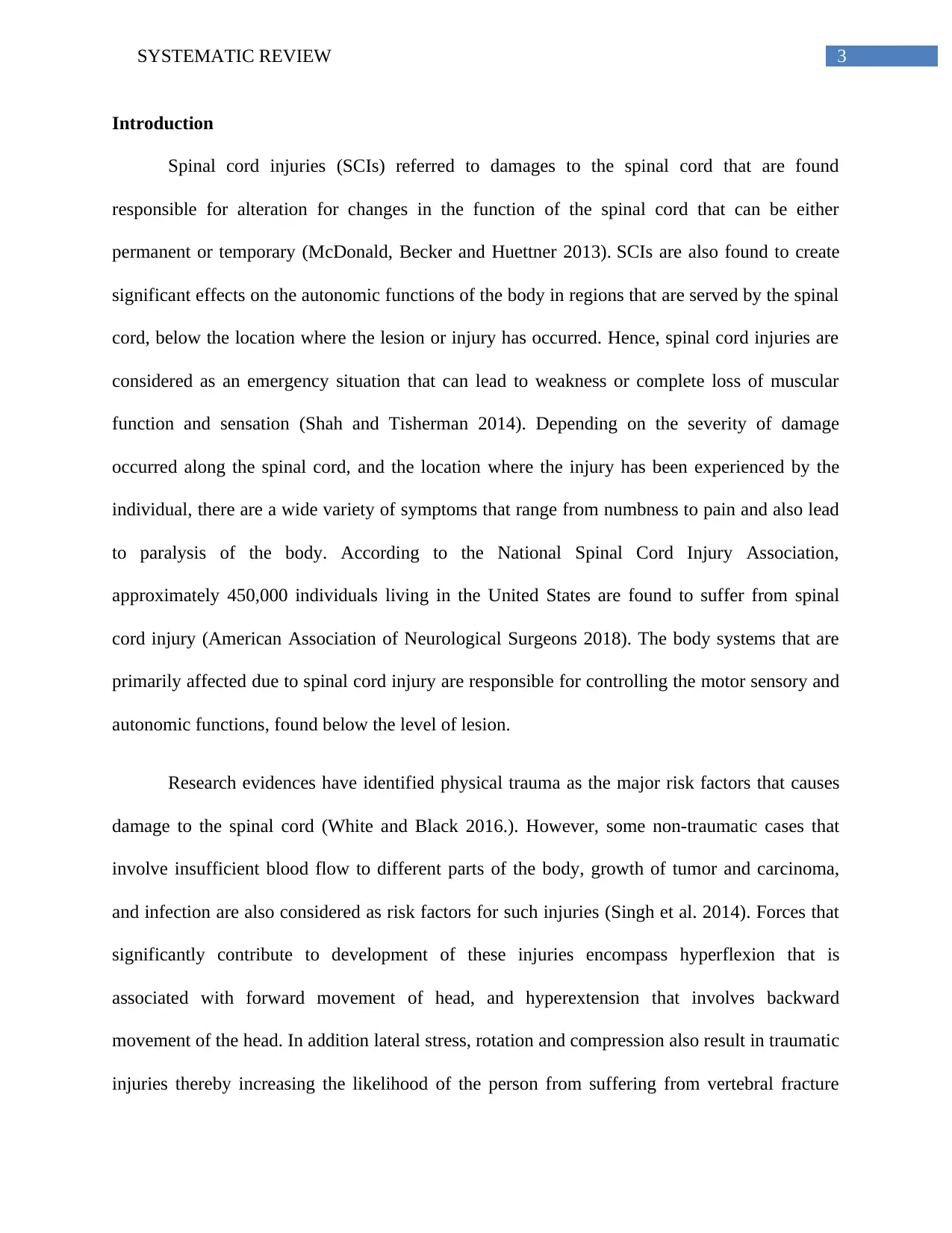
3SYSTEMATIC REVIEW
Introduction
Spinal cord injuries (SCIs) referred to damages to the spinal cord that are found
responsible for alteration for changes in the function of the spinal cord that can be either
permanent or temporary (McDonald, Becker and Huettner 2013). SCIs are also found to create
significant effects on the autonomic functions of the body in regions that are served by the spinal
cord, below the location where the lesion or injury has occurred. Hence, spinal cord injuries are
considered as an emergency situation that can lead to weakness or complete loss of muscular
function and sensation (Shah and Tisherman 2014). Depending on the severity of damage
occurred along the spinal cord, and the location where the injury has been experienced by the
individual, there are a wide variety of symptoms that range from numbness to pain and also lead
to paralysis of the body. According to the National Spinal Cord Injury Association,
approximately 450,000 individuals living in the United States are found to suffer from spinal
cord injury (American Association of Neurological Surgeons 2018). The body systems that are
primarily affected due to spinal cord injury are responsible for controlling the motor sensory and
autonomic functions, found below the level of lesion.
Research evidences have identified physical trauma as the major risk factors that causes
damage to the spinal cord (White and Black 2016.). However, some non-traumatic cases that
involve insufficient blood flow to different parts of the body, growth of tumor and carcinoma,
and infection are also considered as risk factors for such injuries (Singh et al. 2014). Forces that
significantly contribute to development of these injuries encompass hyperflexion that is
associated with forward movement of head, and hyperextension that involves backward
movement of the head. In addition lateral stress, rotation and compression also result in traumatic
injuries thereby increasing the likelihood of the person from suffering from vertebral fracture
Introduction
Spinal cord injuries (SCIs) referred to damages to the spinal cord that are found
responsible for alteration for changes in the function of the spinal cord that can be either
permanent or temporary (McDonald, Becker and Huettner 2013). SCIs are also found to create
significant effects on the autonomic functions of the body in regions that are served by the spinal
cord, below the location where the lesion or injury has occurred. Hence, spinal cord injuries are
considered as an emergency situation that can lead to weakness or complete loss of muscular
function and sensation (Shah and Tisherman 2014). Depending on the severity of damage
occurred along the spinal cord, and the location where the injury has been experienced by the
individual, there are a wide variety of symptoms that range from numbness to pain and also lead
to paralysis of the body. According to the National Spinal Cord Injury Association,
approximately 450,000 individuals living in the United States are found to suffer from spinal
cord injury (American Association of Neurological Surgeons 2018). The body systems that are
primarily affected due to spinal cord injury are responsible for controlling the motor sensory and
autonomic functions, found below the level of lesion.
Research evidences have identified physical trauma as the major risk factors that causes
damage to the spinal cord (White and Black 2016.). However, some non-traumatic cases that
involve insufficient blood flow to different parts of the body, growth of tumor and carcinoma,
and infection are also considered as risk factors for such injuries (Singh et al. 2014). Forces that
significantly contribute to development of these injuries encompass hyperflexion that is
associated with forward movement of head, and hyperextension that involves backward
movement of the head. In addition lateral stress, rotation and compression also result in traumatic
injuries thereby increasing the likelihood of the person from suffering from vertebral fracture
Paraphrase This Document
Need a fresh take? Get an instant paraphrase of this document with our AI Paraphraser
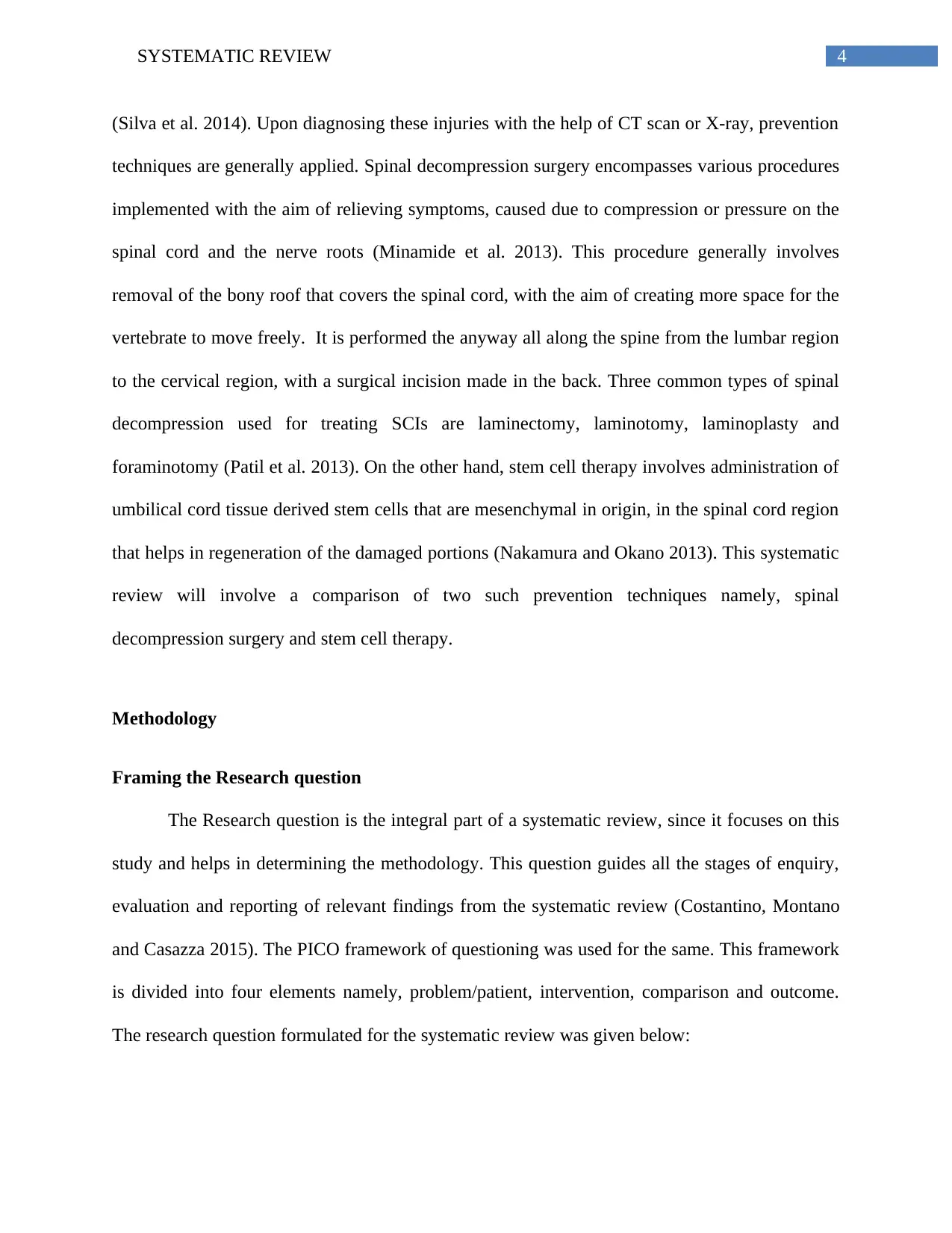
4SYSTEMATIC REVIEW
(Silva et al. 2014). Upon diagnosing these injuries with the help of CT scan or X-ray, prevention
techniques are generally applied. Spinal decompression surgery encompasses various procedures
implemented with the aim of relieving symptoms, caused due to compression or pressure on the
spinal cord and the nerve roots (Minamide et al. 2013). This procedure generally involves
removal of the bony roof that covers the spinal cord, with the aim of creating more space for the
vertebrate to move freely. It is performed the anyway all along the spine from the lumbar region
to the cervical region, with a surgical incision made in the back. Three common types of spinal
decompression used for treating SCIs are laminectomy, laminotomy, laminoplasty and
foraminotomy (Patil et al. 2013). On the other hand, stem cell therapy involves administration of
umbilical cord tissue derived stem cells that are mesenchymal in origin, in the spinal cord region
that helps in regeneration of the damaged portions (Nakamura and Okano 2013). This systematic
review will involve a comparison of two such prevention techniques namely, spinal
decompression surgery and stem cell therapy.
Methodology
Framing the Research question
The Research question is the integral part of a systematic review, since it focuses on this
study and helps in determining the methodology. This question guides all the stages of enquiry,
evaluation and reporting of relevant findings from the systematic review (Costantino, Montano
and Casazza 2015). The PICO framework of questioning was used for the same. This framework
is divided into four elements namely, problem/patient, intervention, comparison and outcome.
The research question formulated for the systematic review was given below:
(Silva et al. 2014). Upon diagnosing these injuries with the help of CT scan or X-ray, prevention
techniques are generally applied. Spinal decompression surgery encompasses various procedures
implemented with the aim of relieving symptoms, caused due to compression or pressure on the
spinal cord and the nerve roots (Minamide et al. 2013). This procedure generally involves
removal of the bony roof that covers the spinal cord, with the aim of creating more space for the
vertebrate to move freely. It is performed the anyway all along the spine from the lumbar region
to the cervical region, with a surgical incision made in the back. Three common types of spinal
decompression used for treating SCIs are laminectomy, laminotomy, laminoplasty and
foraminotomy (Patil et al. 2013). On the other hand, stem cell therapy involves administration of
umbilical cord tissue derived stem cells that are mesenchymal in origin, in the spinal cord region
that helps in regeneration of the damaged portions (Nakamura and Okano 2013). This systematic
review will involve a comparison of two such prevention techniques namely, spinal
decompression surgery and stem cell therapy.
Methodology
Framing the Research question
The Research question is the integral part of a systematic review, since it focuses on this
study and helps in determining the methodology. This question guides all the stages of enquiry,
evaluation and reporting of relevant findings from the systematic review (Costantino, Montano
and Casazza 2015). The PICO framework of questioning was used for the same. This framework
is divided into four elements namely, problem/patient, intervention, comparison and outcome.
The research question formulated for the systematic review was given below:
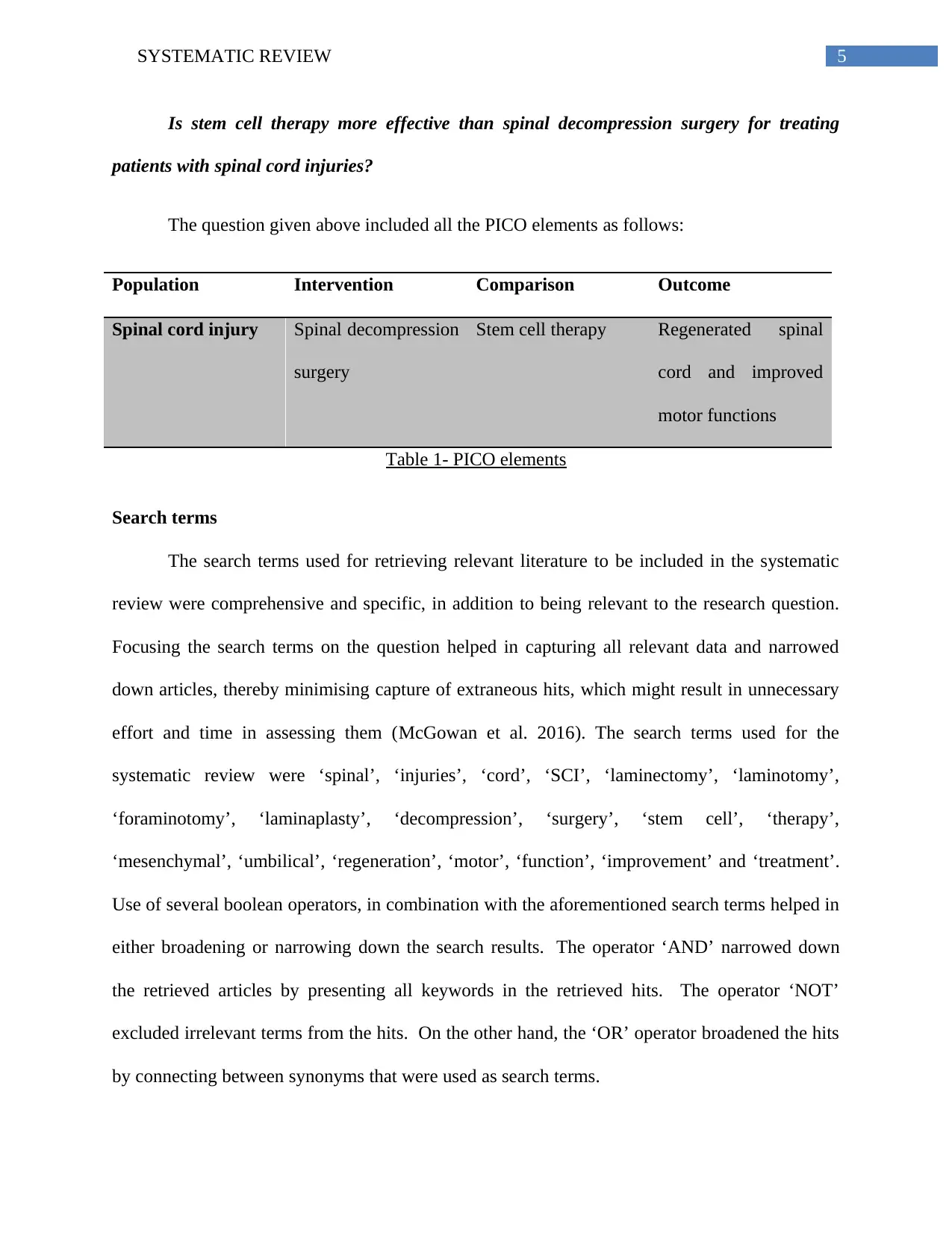
5SYSTEMATIC REVIEW
Is stem cell therapy more effective than spinal decompression surgery for treating
patients with spinal cord injuries?
The question given above included all the PICO elements as follows:
Population Intervention Comparison Outcome
Spinal cord injury Spinal decompression
surgery
Stem cell therapy Regenerated spinal
cord and improved
motor functions
Table 1- PICO elements
Search terms
The search terms used for retrieving relevant literature to be included in the systematic
review were comprehensive and specific, in addition to being relevant to the research question.
Focusing the search terms on the question helped in capturing all relevant data and narrowed
down articles, thereby minimising capture of extraneous hits, which might result in unnecessary
effort and time in assessing them (McGowan et al. 2016). The search terms used for the
systematic review were ‘spinal’, ‘injuries’, ‘cord’, ‘SCI’, ‘laminectomy’, ‘laminotomy’,
‘foraminotomy’, ‘laminaplasty’, ‘decompression’, ‘surgery’, ‘stem cell’, ‘therapy’,
‘mesenchymal’, ‘umbilical’, ‘regeneration’, ‘motor’, ‘function’, ‘improvement’ and ‘treatment’.
Use of several boolean operators, in combination with the aforementioned search terms helped in
either broadening or narrowing down the search results. The operator ‘AND’ narrowed down
the retrieved articles by presenting all keywords in the retrieved hits. The operator ‘NOT’
excluded irrelevant terms from the hits. On the other hand, the ‘OR’ operator broadened the hits
by connecting between synonyms that were used as search terms.
Is stem cell therapy more effective than spinal decompression surgery for treating
patients with spinal cord injuries?
The question given above included all the PICO elements as follows:
Population Intervention Comparison Outcome
Spinal cord injury Spinal decompression
surgery
Stem cell therapy Regenerated spinal
cord and improved
motor functions
Table 1- PICO elements
Search terms
The search terms used for retrieving relevant literature to be included in the systematic
review were comprehensive and specific, in addition to being relevant to the research question.
Focusing the search terms on the question helped in capturing all relevant data and narrowed
down articles, thereby minimising capture of extraneous hits, which might result in unnecessary
effort and time in assessing them (McGowan et al. 2016). The search terms used for the
systematic review were ‘spinal’, ‘injuries’, ‘cord’, ‘SCI’, ‘laminectomy’, ‘laminotomy’,
‘foraminotomy’, ‘laminaplasty’, ‘decompression’, ‘surgery’, ‘stem cell’, ‘therapy’,
‘mesenchymal’, ‘umbilical’, ‘regeneration’, ‘motor’, ‘function’, ‘improvement’ and ‘treatment’.
Use of several boolean operators, in combination with the aforementioned search terms helped in
either broadening or narrowing down the search results. The operator ‘AND’ narrowed down
the retrieved articles by presenting all keywords in the retrieved hits. The operator ‘NOT’
excluded irrelevant terms from the hits. On the other hand, the ‘OR’ operator broadened the hits
by connecting between synonyms that were used as search terms.
⊘ This is a preview!⊘
Do you want full access?
Subscribe today to unlock all pages.

Trusted by 1+ million students worldwide
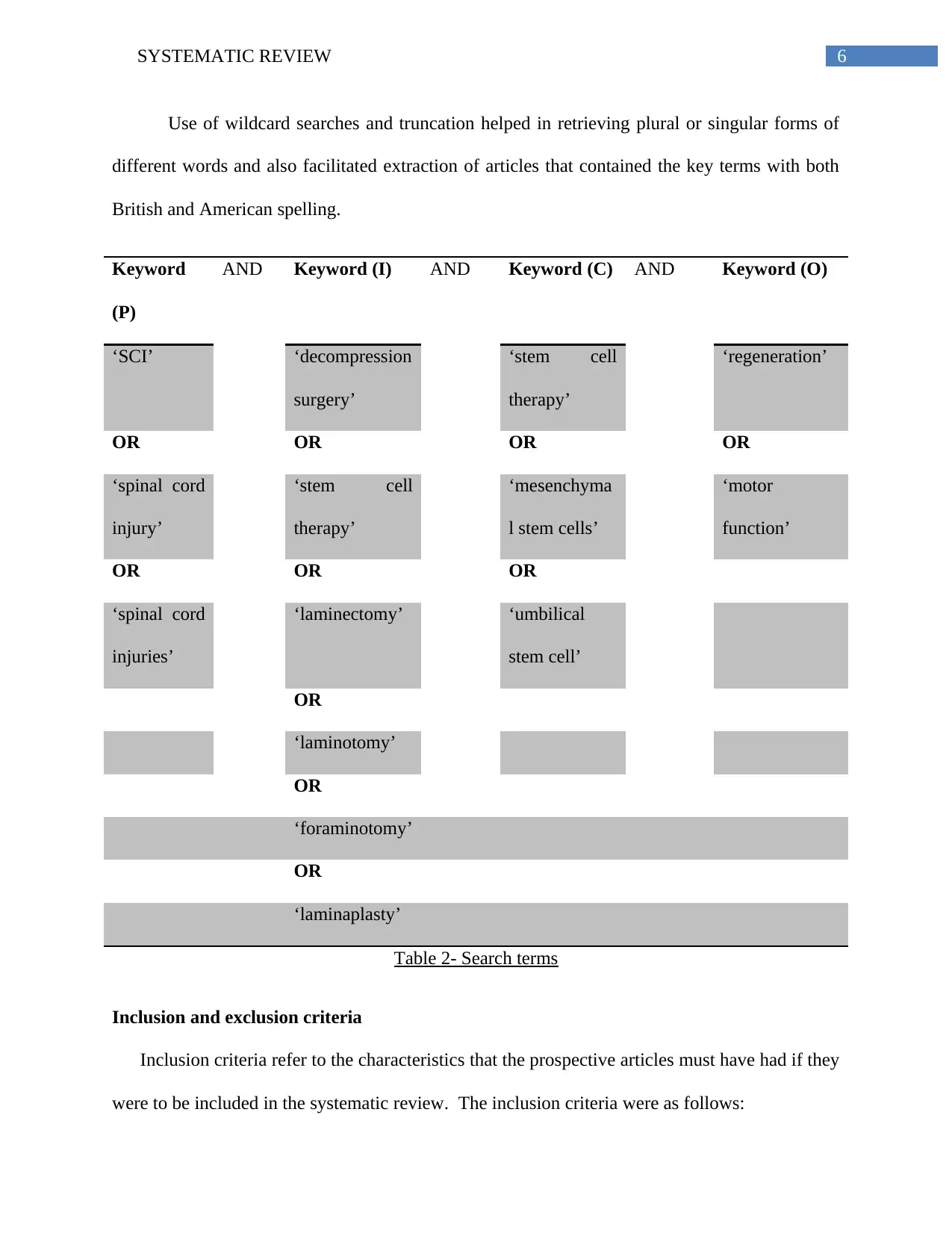
6SYSTEMATIC REVIEW
Use of wildcard searches and truncation helped in retrieving plural or singular forms of
different words and also facilitated extraction of articles that contained the key terms with both
British and American spelling.
Keyword
(P)
AND Keyword (I) AND Keyword (C) AND Keyword (O)
‘SCI’ ‘decompression
surgery’
‘stem cell
therapy’
‘regeneration’
OR OR OR OR
‘spinal cord
injury’
‘stem cell
therapy’
‘mesenchyma
l stem cells’
‘motor
function’
OR OR OR
‘spinal cord
injuries’
‘laminectomy’ ‘umbilical
stem cell’
OR
‘laminotomy’
OR
‘foraminotomy’
OR
‘laminaplasty’
Table 2- Search terms
Inclusion and exclusion criteria
Inclusion criteria refer to the characteristics that the prospective articles must have had if they
were to be included in the systematic review. The inclusion criteria were as follows:
Use of wildcard searches and truncation helped in retrieving plural or singular forms of
different words and also facilitated extraction of articles that contained the key terms with both
British and American spelling.
Keyword
(P)
AND Keyword (I) AND Keyword (C) AND Keyword (O)
‘SCI’ ‘decompression
surgery’
‘stem cell
therapy’
‘regeneration’
OR OR OR OR
‘spinal cord
injury’
‘stem cell
therapy’
‘mesenchyma
l stem cells’
‘motor
function’
OR OR OR
‘spinal cord
injuries’
‘laminectomy’ ‘umbilical
stem cell’
OR
‘laminotomy’
OR
‘foraminotomy’
OR
‘laminaplasty’
Table 2- Search terms
Inclusion and exclusion criteria
Inclusion criteria refer to the characteristics that the prospective articles must have had if they
were to be included in the systematic review. The inclusion criteria were as follows:
Paraphrase This Document
Need a fresh take? Get an instant paraphrase of this document with our AI Paraphraser
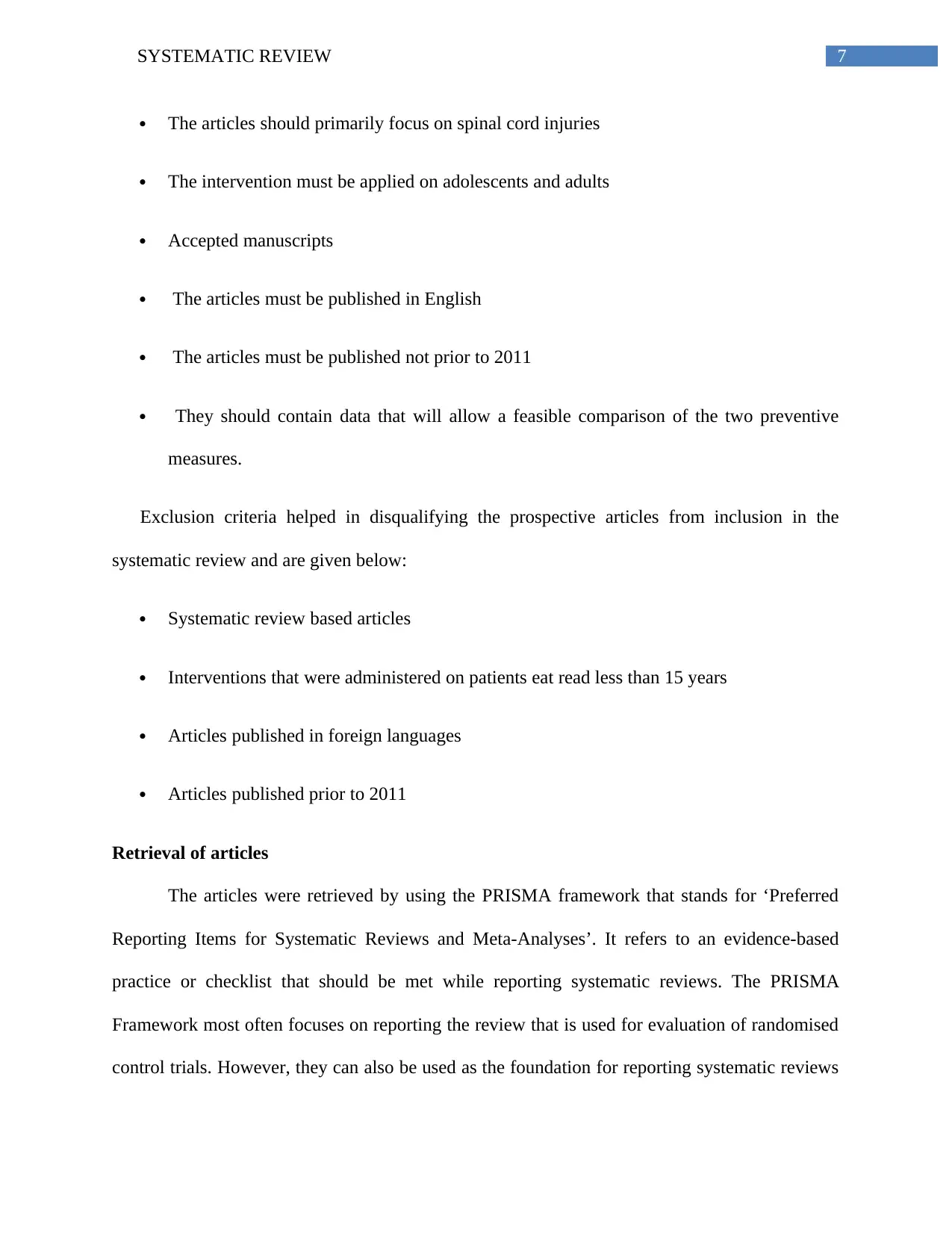
7SYSTEMATIC REVIEW
The articles should primarily focus on spinal cord injuries
The intervention must be applied on adolescents and adults
Accepted manuscripts
The articles must be published in English
The articles must be published not prior to 2011
They should contain data that will allow a feasible comparison of the two preventive
measures.
Exclusion criteria helped in disqualifying the prospective articles from inclusion in the
systematic review and are given below:
Systematic review based articles
Interventions that were administered on patients eat read less than 15 years
Articles published in foreign languages
Articles published prior to 2011
Retrieval of articles
The articles were retrieved by using the PRISMA framework that stands for ‘Preferred
Reporting Items for Systematic Reviews and Meta-Analyses’. It refers to an evidence-based
practice or checklist that should be met while reporting systematic reviews. The PRISMA
Framework most often focuses on reporting the review that is used for evaluation of randomised
control trials. However, they can also be used as the foundation for reporting systematic reviews
The articles should primarily focus on spinal cord injuries
The intervention must be applied on adolescents and adults
Accepted manuscripts
The articles must be published in English
The articles must be published not prior to 2011
They should contain data that will allow a feasible comparison of the two preventive
measures.
Exclusion criteria helped in disqualifying the prospective articles from inclusion in the
systematic review and are given below:
Systematic review based articles
Interventions that were administered on patients eat read less than 15 years
Articles published in foreign languages
Articles published prior to 2011
Retrieval of articles
The articles were retrieved by using the PRISMA framework that stands for ‘Preferred
Reporting Items for Systematic Reviews and Meta-Analyses’. It refers to an evidence-based
practice or checklist that should be met while reporting systematic reviews. The PRISMA
Framework most often focuses on reporting the review that is used for evaluation of randomised
control trials. However, they can also be used as the foundation for reporting systematic reviews
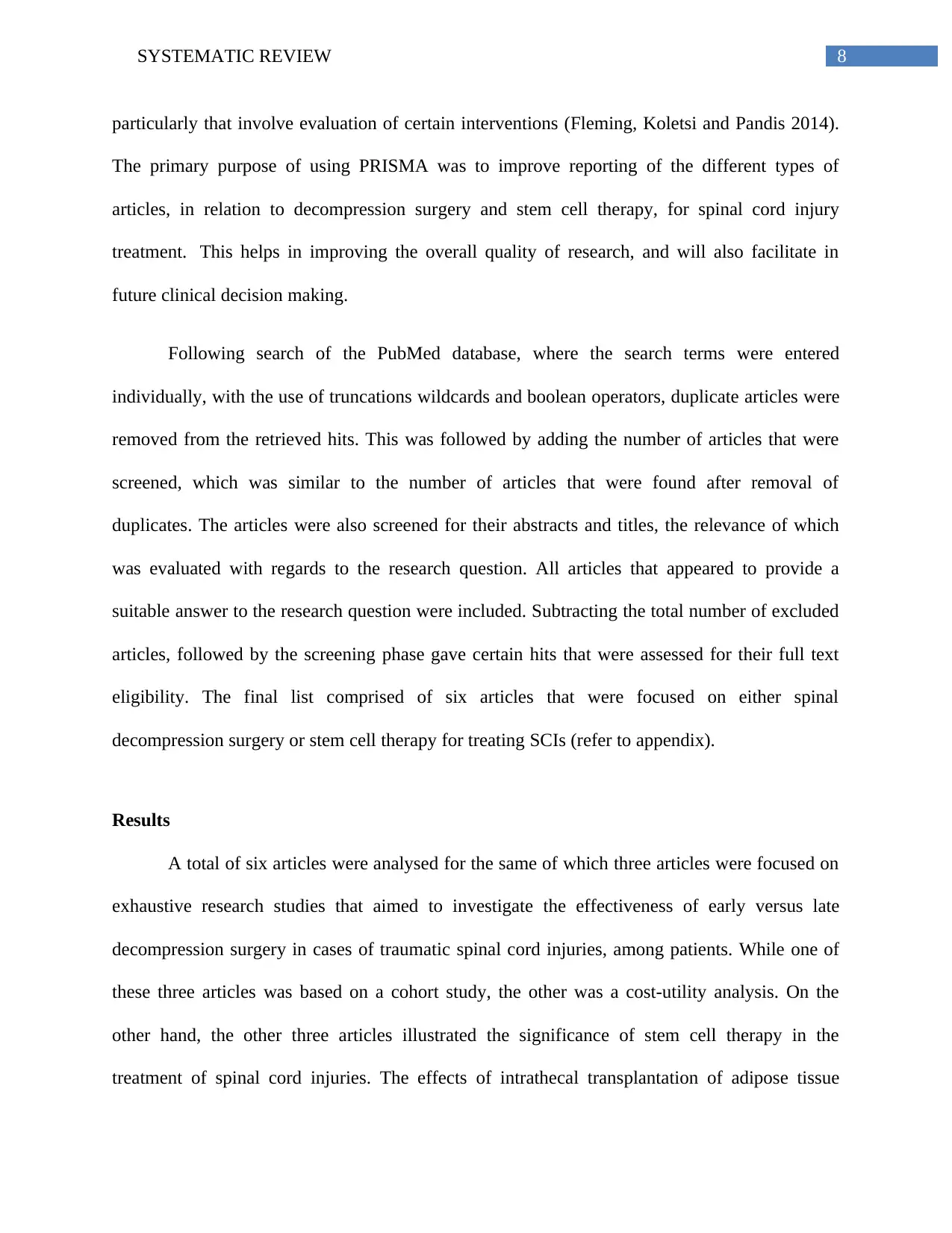
8SYSTEMATIC REVIEW
particularly that involve evaluation of certain interventions (Fleming, Koletsi and Pandis 2014).
The primary purpose of using PRISMA was to improve reporting of the different types of
articles, in relation to decompression surgery and stem cell therapy, for spinal cord injury
treatment. This helps in improving the overall quality of research, and will also facilitate in
future clinical decision making.
Following search of the PubMed database, where the search terms were entered
individually, with the use of truncations wildcards and boolean operators, duplicate articles were
removed from the retrieved hits. This was followed by adding the number of articles that were
screened, which was similar to the number of articles that were found after removal of
duplicates. The articles were also screened for their abstracts and titles, the relevance of which
was evaluated with regards to the research question. All articles that appeared to provide a
suitable answer to the research question were included. Subtracting the total number of excluded
articles, followed by the screening phase gave certain hits that were assessed for their full text
eligibility. The final list comprised of six articles that were focused on either spinal
decompression surgery or stem cell therapy for treating SCIs (refer to appendix).
Results
A total of six articles were analysed for the same of which three articles were focused on
exhaustive research studies that aimed to investigate the effectiveness of early versus late
decompression surgery in cases of traumatic spinal cord injuries, among patients. While one of
these three articles was based on a cohort study, the other was a cost-utility analysis. On the
other hand, the other three articles illustrated the significance of stem cell therapy in the
treatment of spinal cord injuries. The effects of intrathecal transplantation of adipose tissue
particularly that involve evaluation of certain interventions (Fleming, Koletsi and Pandis 2014).
The primary purpose of using PRISMA was to improve reporting of the different types of
articles, in relation to decompression surgery and stem cell therapy, for spinal cord injury
treatment. This helps in improving the overall quality of research, and will also facilitate in
future clinical decision making.
Following search of the PubMed database, where the search terms were entered
individually, with the use of truncations wildcards and boolean operators, duplicate articles were
removed from the retrieved hits. This was followed by adding the number of articles that were
screened, which was similar to the number of articles that were found after removal of
duplicates. The articles were also screened for their abstracts and titles, the relevance of which
was evaluated with regards to the research question. All articles that appeared to provide a
suitable answer to the research question were included. Subtracting the total number of excluded
articles, followed by the screening phase gave certain hits that were assessed for their full text
eligibility. The final list comprised of six articles that were focused on either spinal
decompression surgery or stem cell therapy for treating SCIs (refer to appendix).
Results
A total of six articles were analysed for the same of which three articles were focused on
exhaustive research studies that aimed to investigate the effectiveness of early versus late
decompression surgery in cases of traumatic spinal cord injuries, among patients. While one of
these three articles was based on a cohort study, the other was a cost-utility analysis. On the
other hand, the other three articles illustrated the significance of stem cell therapy in the
treatment of spinal cord injuries. The effects of intrathecal transplantation of adipose tissue
⊘ This is a preview!⊘
Do you want full access?
Subscribe today to unlock all pages.

Trusted by 1+ million students worldwide
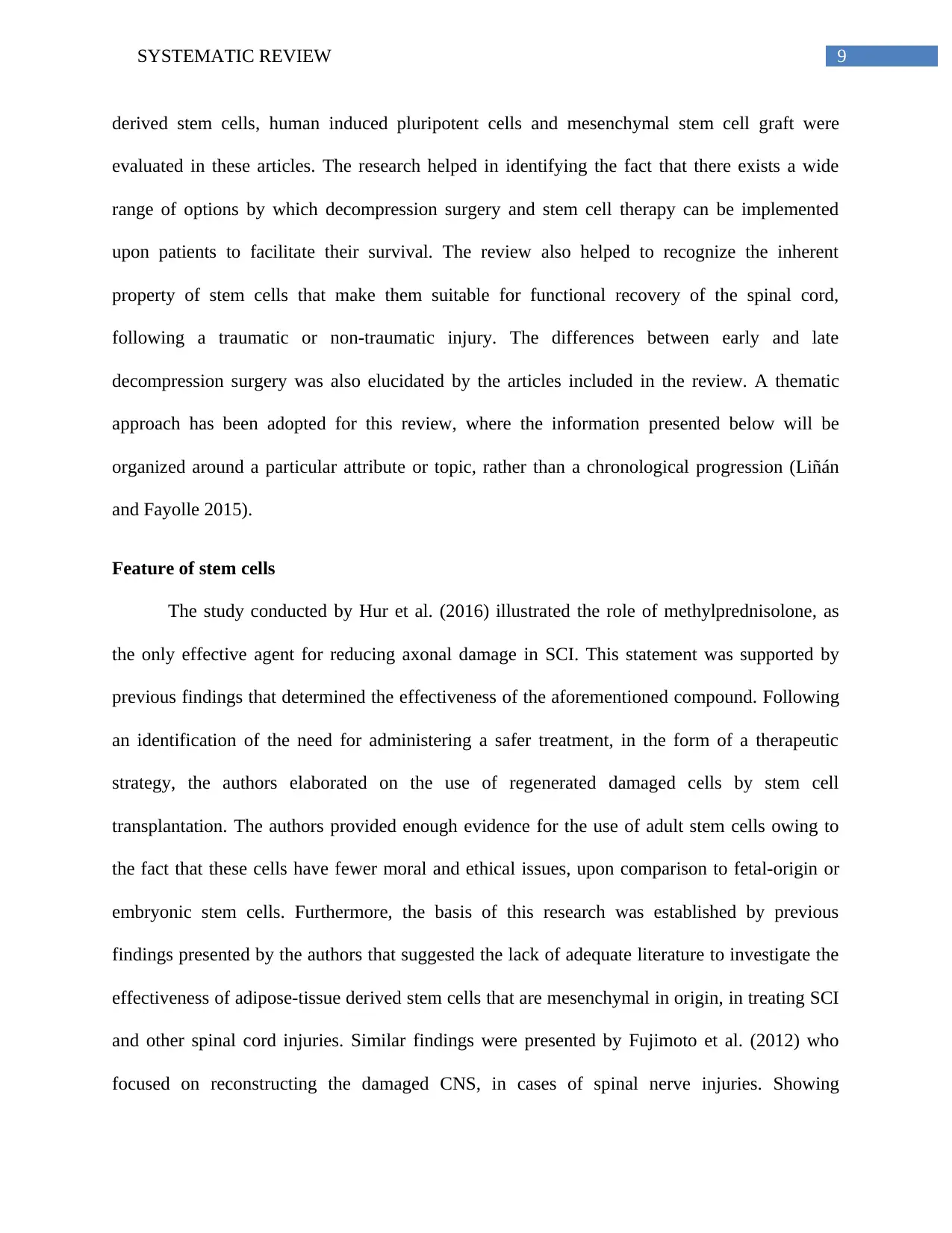
9SYSTEMATIC REVIEW
derived stem cells, human induced pluripotent cells and mesenchymal stem cell graft were
evaluated in these articles. The research helped in identifying the fact that there exists a wide
range of options by which decompression surgery and stem cell therapy can be implemented
upon patients to facilitate their survival. The review also helped to recognize the inherent
property of stem cells that make them suitable for functional recovery of the spinal cord,
following a traumatic or non-traumatic injury. The differences between early and late
decompression surgery was also elucidated by the articles included in the review. A thematic
approach has been adopted for this review, where the information presented below will be
organized around a particular attribute or topic, rather than a chronological progression (Liñán
and Fayolle 2015).
Feature of stem cells
The study conducted by Hur et al. (2016) illustrated the role of methylprednisolone, as
the only effective agent for reducing axonal damage in SCI. This statement was supported by
previous findings that determined the effectiveness of the aforementioned compound. Following
an identification of the need for administering a safer treatment, in the form of a therapeutic
strategy, the authors elaborated on the use of regenerated damaged cells by stem cell
transplantation. The authors provided enough evidence for the use of adult stem cells owing to
the fact that these cells have fewer moral and ethical issues, upon comparison to fetal-origin or
embryonic stem cells. Furthermore, the basis of this research was established by previous
findings presented by the authors that suggested the lack of adequate literature to investigate the
effectiveness of adipose-tissue derived stem cells that are mesenchymal in origin, in treating SCI
and other spinal cord injuries. Similar findings were presented by Fujimoto et al. (2012) who
focused on reconstructing the damaged CNS, in cases of spinal nerve injuries. Showing
derived stem cells, human induced pluripotent cells and mesenchymal stem cell graft were
evaluated in these articles. The research helped in identifying the fact that there exists a wide
range of options by which decompression surgery and stem cell therapy can be implemented
upon patients to facilitate their survival. The review also helped to recognize the inherent
property of stem cells that make them suitable for functional recovery of the spinal cord,
following a traumatic or non-traumatic injury. The differences between early and late
decompression surgery was also elucidated by the articles included in the review. A thematic
approach has been adopted for this review, where the information presented below will be
organized around a particular attribute or topic, rather than a chronological progression (Liñán
and Fayolle 2015).
Feature of stem cells
The study conducted by Hur et al. (2016) illustrated the role of methylprednisolone, as
the only effective agent for reducing axonal damage in SCI. This statement was supported by
previous findings that determined the effectiveness of the aforementioned compound. Following
an identification of the need for administering a safer treatment, in the form of a therapeutic
strategy, the authors elaborated on the use of regenerated damaged cells by stem cell
transplantation. The authors provided enough evidence for the use of adult stem cells owing to
the fact that these cells have fewer moral and ethical issues, upon comparison to fetal-origin or
embryonic stem cells. Furthermore, the basis of this research was established by previous
findings presented by the authors that suggested the lack of adequate literature to investigate the
effectiveness of adipose-tissue derived stem cells that are mesenchymal in origin, in treating SCI
and other spinal cord injuries. Similar findings were presented by Fujimoto et al. (2012) who
focused on reconstructing the damaged CNS, in cases of spinal nerve injuries. Showing
Paraphrase This Document
Need a fresh take? Get an instant paraphrase of this document with our AI Paraphraser
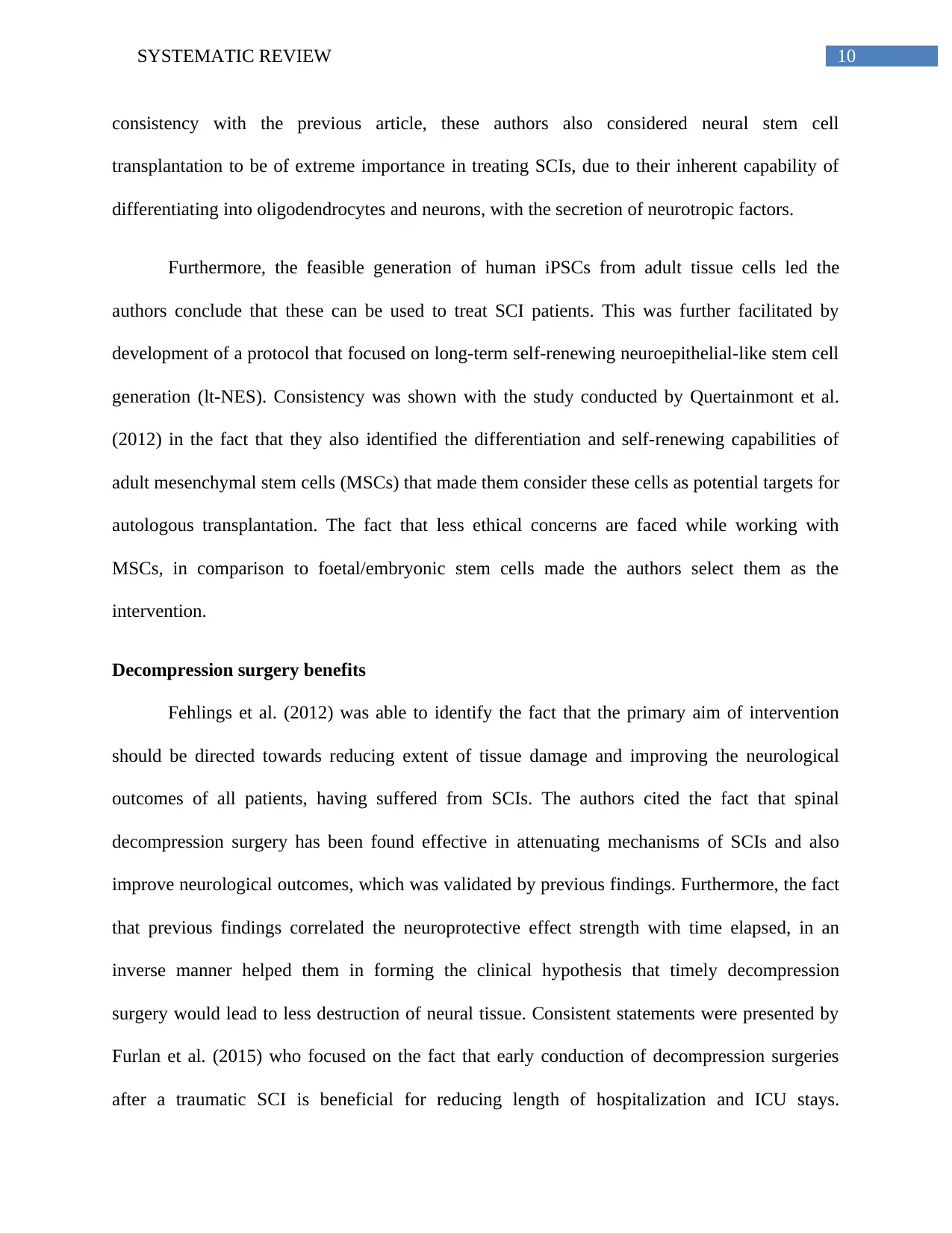
10SYSTEMATIC REVIEW
consistency with the previous article, these authors also considered neural stem cell
transplantation to be of extreme importance in treating SCIs, due to their inherent capability of
differentiating into oligodendrocytes and neurons, with the secretion of neurotropic factors.
Furthermore, the feasible generation of human iPSCs from adult tissue cells led the
authors conclude that these can be used to treat SCI patients. This was further facilitated by
development of a protocol that focused on long-term self-renewing neuroepithelial-like stem cell
generation (lt-NES). Consistency was shown with the study conducted by Quertainmont et al.
(2012) in the fact that they also identified the differentiation and self-renewing capabilities of
adult mesenchymal stem cells (MSCs) that made them consider these cells as potential targets for
autologous transplantation. The fact that less ethical concerns are faced while working with
MSCs, in comparison to foetal/embryonic stem cells made the authors select them as the
intervention.
Decompression surgery benefits
Fehlings et al. (2012) was able to identify the fact that the primary aim of intervention
should be directed towards reducing extent of tissue damage and improving the neurological
outcomes of all patients, having suffered from SCIs. The authors cited the fact that spinal
decompression surgery has been found effective in attenuating mechanisms of SCIs and also
improve neurological outcomes, which was validated by previous findings. Furthermore, the fact
that previous findings correlated the neuroprotective effect strength with time elapsed, in an
inverse manner helped them in forming the clinical hypothesis that timely decompression
surgery would lead to less destruction of neural tissue. Consistent statements were presented by
Furlan et al. (2015) who focused on the fact that early conduction of decompression surgeries
after a traumatic SCI is beneficial for reducing length of hospitalization and ICU stays.
consistency with the previous article, these authors also considered neural stem cell
transplantation to be of extreme importance in treating SCIs, due to their inherent capability of
differentiating into oligodendrocytes and neurons, with the secretion of neurotropic factors.
Furthermore, the feasible generation of human iPSCs from adult tissue cells led the
authors conclude that these can be used to treat SCI patients. This was further facilitated by
development of a protocol that focused on long-term self-renewing neuroepithelial-like stem cell
generation (lt-NES). Consistency was shown with the study conducted by Quertainmont et al.
(2012) in the fact that they also identified the differentiation and self-renewing capabilities of
adult mesenchymal stem cells (MSCs) that made them consider these cells as potential targets for
autologous transplantation. The fact that less ethical concerns are faced while working with
MSCs, in comparison to foetal/embryonic stem cells made the authors select them as the
intervention.
Decompression surgery benefits
Fehlings et al. (2012) was able to identify the fact that the primary aim of intervention
should be directed towards reducing extent of tissue damage and improving the neurological
outcomes of all patients, having suffered from SCIs. The authors cited the fact that spinal
decompression surgery has been found effective in attenuating mechanisms of SCIs and also
improve neurological outcomes, which was validated by previous findings. Furthermore, the fact
that previous findings correlated the neuroprotective effect strength with time elapsed, in an
inverse manner helped them in forming the clinical hypothesis that timely decompression
surgery would lead to less destruction of neural tissue. Consistent statements were presented by
Furlan et al. (2015) who focused on the fact that early conduction of decompression surgeries
after a traumatic SCI is beneficial for reducing length of hospitalization and ICU stays.
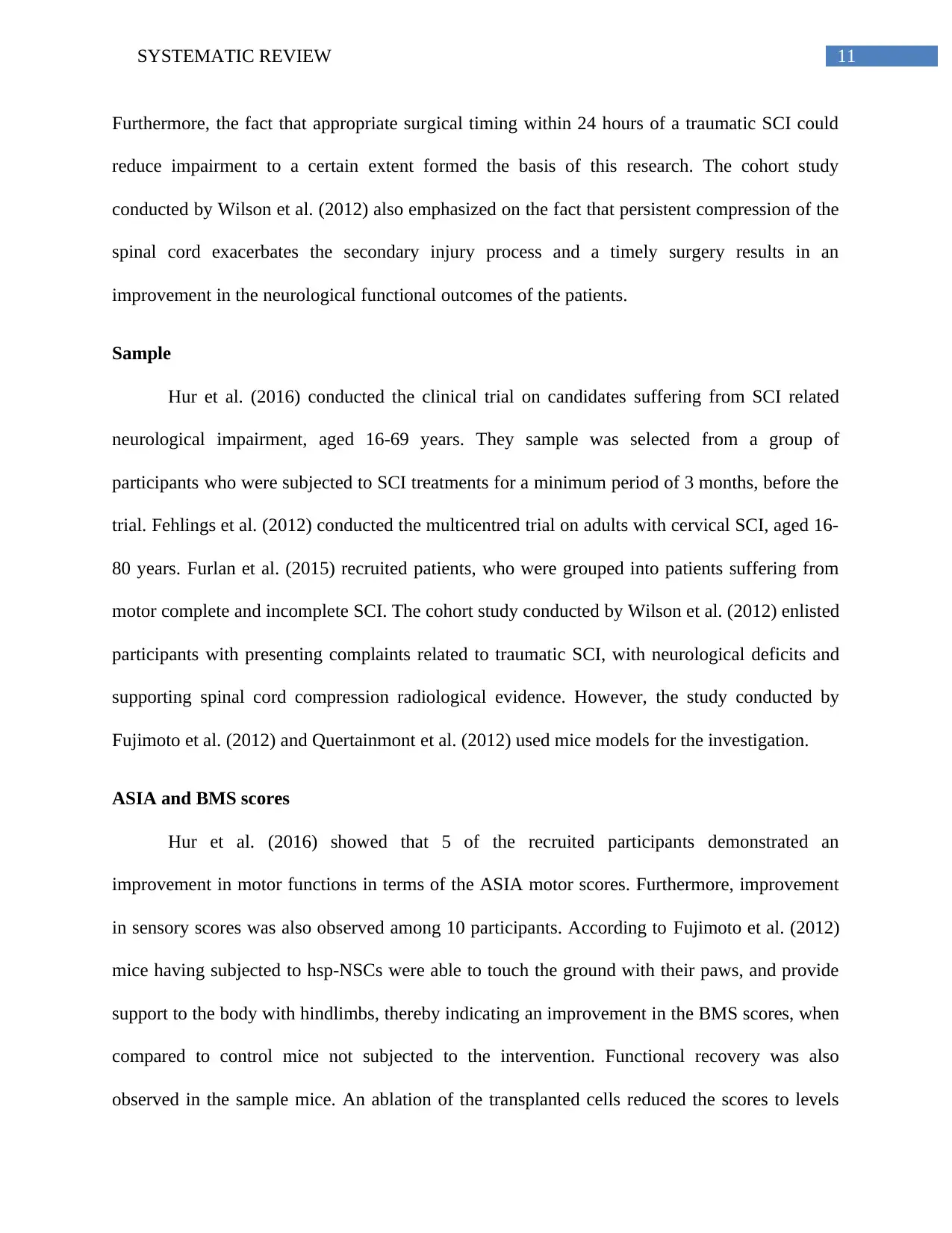
11SYSTEMATIC REVIEW
Furthermore, the fact that appropriate surgical timing within 24 hours of a traumatic SCI could
reduce impairment to a certain extent formed the basis of this research. The cohort study
conducted by Wilson et al. (2012) also emphasized on the fact that persistent compression of the
spinal cord exacerbates the secondary injury process and a timely surgery results in an
improvement in the neurological functional outcomes of the patients.
Sample
Hur et al. (2016) conducted the clinical trial on candidates suffering from SCI related
neurological impairment, aged 16-69 years. They sample was selected from a group of
participants who were subjected to SCI treatments for a minimum period of 3 months, before the
trial. Fehlings et al. (2012) conducted the multicentred trial on adults with cervical SCI, aged 16-
80 years. Furlan et al. (2015) recruited patients, who were grouped into patients suffering from
motor complete and incomplete SCI. The cohort study conducted by Wilson et al. (2012) enlisted
participants with presenting complaints related to traumatic SCI, with neurological deficits and
supporting spinal cord compression radiological evidence. However, the study conducted by
Fujimoto et al. (2012) and Quertainmont et al. (2012) used mice models for the investigation.
ASIA and BMS scores
Hur et al. (2016) showed that 5 of the recruited participants demonstrated an
improvement in motor functions in terms of the ASIA motor scores. Furthermore, improvement
in sensory scores was also observed among 10 participants. According to Fujimoto et al. (2012)
mice having subjected to hsp-NSCs were able to touch the ground with their paws, and provide
support to the body with hindlimbs, thereby indicating an improvement in the BMS scores, when
compared to control mice not subjected to the intervention. Functional recovery was also
observed in the sample mice. An ablation of the transplanted cells reduced the scores to levels
Furthermore, the fact that appropriate surgical timing within 24 hours of a traumatic SCI could
reduce impairment to a certain extent formed the basis of this research. The cohort study
conducted by Wilson et al. (2012) also emphasized on the fact that persistent compression of the
spinal cord exacerbates the secondary injury process and a timely surgery results in an
improvement in the neurological functional outcomes of the patients.
Sample
Hur et al. (2016) conducted the clinical trial on candidates suffering from SCI related
neurological impairment, aged 16-69 years. They sample was selected from a group of
participants who were subjected to SCI treatments for a minimum period of 3 months, before the
trial. Fehlings et al. (2012) conducted the multicentred trial on adults with cervical SCI, aged 16-
80 years. Furlan et al. (2015) recruited patients, who were grouped into patients suffering from
motor complete and incomplete SCI. The cohort study conducted by Wilson et al. (2012) enlisted
participants with presenting complaints related to traumatic SCI, with neurological deficits and
supporting spinal cord compression radiological evidence. However, the study conducted by
Fujimoto et al. (2012) and Quertainmont et al. (2012) used mice models for the investigation.
ASIA and BMS scores
Hur et al. (2016) showed that 5 of the recruited participants demonstrated an
improvement in motor functions in terms of the ASIA motor scores. Furthermore, improvement
in sensory scores was also observed among 10 participants. According to Fujimoto et al. (2012)
mice having subjected to hsp-NSCs were able to touch the ground with their paws, and provide
support to the body with hindlimbs, thereby indicating an improvement in the BMS scores, when
compared to control mice not subjected to the intervention. Functional recovery was also
observed in the sample mice. An ablation of the transplanted cells reduced the scores to levels
⊘ This is a preview!⊘
Do you want full access?
Subscribe today to unlock all pages.

Trusted by 1+ million students worldwide
1 out of 20
Related Documents
Your All-in-One AI-Powered Toolkit for Academic Success.
+13062052269
info@desklib.com
Available 24*7 on WhatsApp / Email
![[object Object]](/_next/static/media/star-bottom.7253800d.svg)
Unlock your academic potential
Copyright © 2020–2025 A2Z Services. All Rights Reserved. Developed and managed by ZUCOL.




